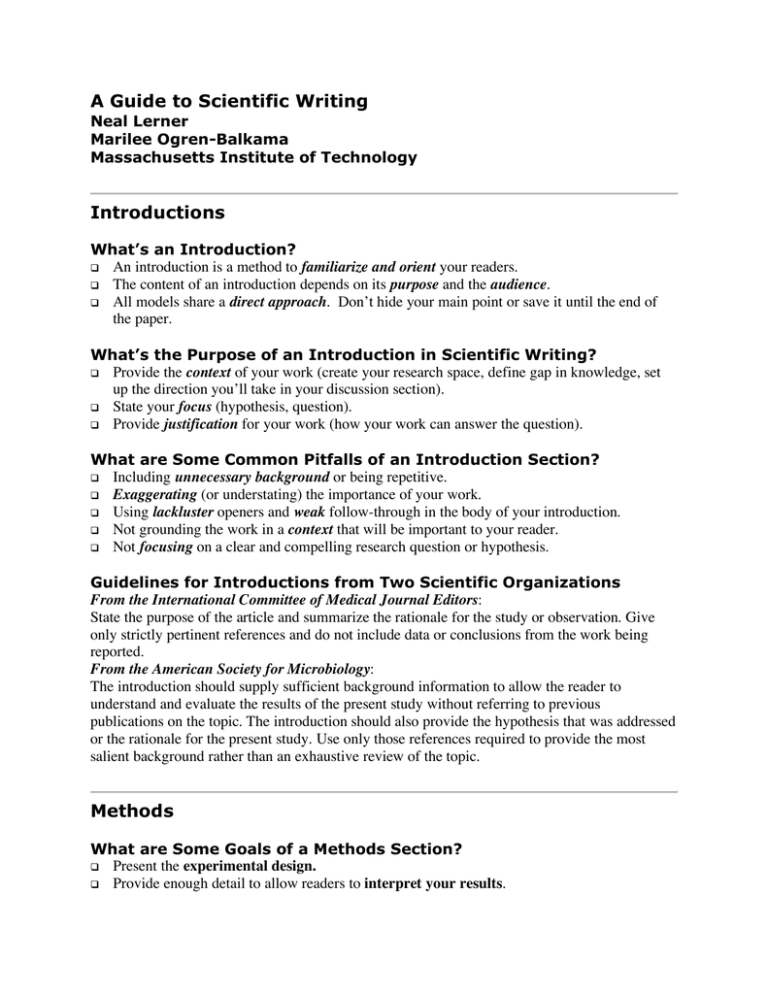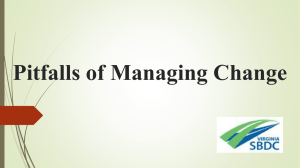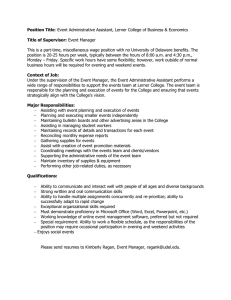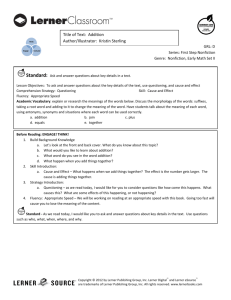A Guide to Scientific Writing Introductions
advertisement

A Guide to Scientific Writing Neal Lerner Marilee Ogren-Balkama Massachusetts Institute of Technology Introductions What’s an Introduction? An introduction is a method to familiarize and orient your readers. The content of an introduction depends on its purpose and the audience. All models share a direct approach. Don’t hide your main point or save it until the end of the paper. What’s the Purpose of an Introduction in Scientific Writing? Provide the context of your work (create your research space, define gap in knowledge, set up the direction you’ll take in your discussion section). State your focus (hypothesis, question). Provide justification for your work (how your work can answer the question). What are Some Common Pitfalls of an Introduction Section? Including unnecessary background or being repetitive. Exaggerating (or understating) the importance of your work. Using lackluster openers and weak follow-through in the body of your introduction. Not grounding the work in a context that will be important to your reader. Not focusing on a clear and compelling research question or hypothesis. Guidelines for Introductions from Two Scientific Organizations From the International Committee of Medical Journal Editors: State the purpose of the article and summarize the rationale for the study or observation. Give only strictly pertinent references and do not include data or conclusions from the work being reported. From the American Society for Microbiology: The introduction should supply sufficient background information to allow the reader to understand and evaluate the results of the present study without referring to previous publications on the topic. The introduction should also provide the hypothesis that was addressed or the rationale for the present study. Use only those references required to provide the most salient background rather than an exhaustive review of the topic. Methods What are Some Goals of a Methods Section? Present the experimental design. Provide enough detail to allow readers to interpret your results. Lerner & Ogren, A Guide to Scientific Writing p. 2 Give enough detail for readers to replicate your work. “The key to a successful Methods section is to include the right amount of detail--too much, and it begins to sound like a laboratory manual; too little, and no one can repeat what was done.” Successful Scientific Writing, 2nd ed. What are Some Pitfalls of a Methods Section? Providing too little or too much information. Reiterating published methods rather than citing them. Writing strictly in chronological order (alternatives: most important first, most fundamental first, etc.). Methods and results don’t correspond (you have to provide methods for all the experiments you report). Forgetting to use visual organizers that direct readers to specific aspects of the methods section, e.g., subheads. Using a “dangling modifier” because of an over-reliance on passive voice: “After scraping the desired plate in four swipes, the bacteria were placed in 8ml of media with no antibodies.” Failing to provide a context for the methods themselves: “In order to . . . , we . . . “ ⇐ context for the particular method is provided. Writing a Protocol rather than a Methods section. A Protocol is . . . A series of steps to be carried out. Written in sequential or temporal order. Intended for the reader to achieve a final result. A Methods Section is . . A series of steps already completed and is written in past tense. Written in logical order. Intended for the reader to replicate the experiment. Results What is the Purpose of the Results Section? Objectivity: Make the data, just the data, easy to find. Some readers want to interpret your data themselves rather than accepting the interpretation presented in the discussion. Description: Describe the data presented in figures and tables. What Differentiates Results from the Methods? Methods = How the data were accumulated. Results = What data were accumulated. What Differentiates Results from the Discussion? Results = Data presentation (“Experiments showed that . . . .”) Discussion = Data interpretation (“Experiments suggest that . . . .”) Lerner & Ogren, A Guide to Scientific Writing p. 3 What are the Contents of a Results Section? A brief description of the experiment or rationale at the beginning of each subsection (“In order to . . . . As a result, we found that . . . .). The data (in past tense). Descriptive text for FEW determinations. Tables or graphs for REPETITIVE determinations. The data that your methods indicated you would produce (and answering the questions you established in your introduction). What are Some Qualities of a Well-Written Results Section? Methods and Results Correspond. i.e., no experimental results for which there are no methods, and vice versa. Results are presented in a logical order. e.g., most important first, most fundamental first, etc. Results focus on the question(s) or hypothesis introduced earlier in the paper. What are Some Pitfalls of a Results Section? Overstating the results (e.g., “Figure 1 clearly shows…”) Reporting irrelevant results: Although it is sometimes useful to report experiments that didn’t work. Omitting visual organizers, such as subheads. Including inappropriate illustrations. Including methods and/or discussion: Overlap is acceptable in some circumstances. Illustrations What’s the Purpose of Illustrations? Condense large amounts of information Convince readers of your findings (by showing data quality). Focus attention on certain findings (e.g., relationship between values). Simplify complex findings. Promote thinking and discussion. Illustration Caveat: The most beautiful illustration cannot hide lousy content--content is key. What are Some Pitfalls of Figures and Titles/Captions? Figures Not mentioned in text. Textual data inconsistent with figures. Mislabeling. Symbols, data points, unreadable or cluttered. Ugliness (failure to get help from graphic designer). Captions Reiterate results section Written in shorthand, abbreviated form rather than whole sentences. Lerner & Ogren, A Guide to Scientific Writing p. 4 Choose the Most Effective Type (from Successful Scientific Writing, 2nd ed.) To accomplish this: To present exact values, raw data, or data which do not fit into any simple pattern. To summarize trends, show interactions between two or more variables, relate data to constants, or emphasize an overall pattern rather than specific measurements. To dramatize differences or draw comparisons. of Illustration for a Given Goal Choose one of these: Table, list Line graph Bar graph To illustrate complex relationships, spatial configurations, pathways, processes, or interactions. Diagram To compare or contrast. Pictograph, pie chart, bar graph Choose the Most Effective Type of Illustration (cont.) To accomplish this: Choose one of these: To show sequential processes ⇐---------⇒ Flowchart To classify information ⇐---------⇒ Table, list, pictograph To describe parts or circuits. ⇐---------⇒ Schematic To describe a process, organization, or model. Pictograph, flowchart, block diagram To describe a change of state. ⇐---------⇒ Line graph, bar graph To describe proportions. ⇐---------⇒ Pie chart, bar graph To describe relationships. ⇐---------⇒ Table, line graph, block diagram To describe causation. ⇐---------⇒ Flowchart, pictograph To describe an entire object. ⇐---------⇒ Schematic, drawing, photograph To show the vertical or horizontal ⇐---------⇒ Flowchart, drawing tree, block diagram. hierarchy within an object, idea, or organization. Provide Textual Context for Your Illustrations In the body of your article: Refer explicitly to the illustration (e.g., “see Table 1,” “refer to Figure 3.”) Tell the reader: How the graphic advances, supports, clarifies, or summarizes your discussion. Why it is important. What it means. How it supports your argument. Lerner & Ogren, A Guide to Scientific Writing p. 5 Examples of Effective Titles/Legends Figure 1. Initial velocity vs. ONPG substrate concentration for His461. ONPG was added to β-galactosidase extracted from E. coli His461. The initial rates were measured using spectrophotometer A420 readings. Table 1. Increase of Initial Velocity with Increase of Enzyme Concentration. As the concentration of the enzymes His461 and CSH36 are increased, the rate of A420 reading increases, as does the initial velocity (in nmol ONP/ml/min). Figure 1. Optical density readings at 595nm at four known concentrations. The best-fit line is drawn to determine the protein concentration of samples with known optical densities. Discussion/Conclusion What is the Purpose of a Discussion Section? Summarize findings presented in the results section Cite supporting literature. Explain discrepancies between your findings and previous reports. Point out shortcomings of your work and define unsettled points. Discuss theoretical and practical implications of your work. End with a short summary or conclusion about the work’s importance. Questions You Will Address in a Discussion Section What did you expect to find, and why? How did your results compare with those expected? How might you explain any unexpected results? How might you test these potential explanations? Tips for Writing a Discussion Section “This is the place to interpret your results against a background of existing knowledge. Explain what is new in your work, and why it matters. Discuss both the limitations and the implications of your results, and relate observations to other relevant studies. State new hypotheses when warranted, clearly labeled as such. Include recommendations, when appropriate.” Eight Common Components of a Discussion Section (Swales) Background information Statement of results (Un)expected outcome Reference to previous research Explanation Exemplification Deduction and Hypothesis Recommendation What is the Purpose of a Conclusion? “Besides presenting an analysis of the key results in the conclusion sections, you also give a future perspective on the work. In some documents that future perspective might be Lerner & Ogren, A Guide to Scientific Writing p. 6 recommendations. In other documents that future perspective might be a nod to the direction in which your research will head. A third kind of future perspective is to mirror the scope and limitations that you presented in the beginning of the document.” What are the Pitfalls of a Discussion/Conclusion Section? Including too much information (wordy arguments, not focused, meandering, etc.). Failure to follow arguments set up in the introduction. Failure to focus on the current results. Speculating too much or not enough. Improper tense (Discussion largely in present tense). Hedging excessively. Excessive Hedging “The cause of the degenerative changes is unknown but possibly one cause may be infection by a presumed parasite.” Rule of thumb: One hedge word per sentence! Titles/Abstracts What is the purpose of an abstract? A stand alone, mini-version of the paper (250 words or less). Summarizes the main sections of the paper. States the purpose, findings, and impact of the work. Abstracts: The Goal is an Economy of Words Provide an abstracted version of your paper in as few words as possible. Choose each word carefully. Make them clear and significant. Provide only the key points. Language: Needless Words in parentheses (already) existing Mix (together At (the) present (time) Never (before) (basic) fundamentals None (at all) (completely) eliminate Now (at this time) (continue to) remain Period (of time) (currently) being (private) industry (currently) underway (separate) entities (empty) space Start (out) Had done (previously) Write (out) Introduced (a new) (still) persists What are Some Pitfalls of Abstracts? Contains extraneous detail or information or conclusions not stated in the paper. Contains abbreviations, chemical formulas, jargon or references to the literature, tables, or figures. Lerner & Ogren, A Guide to Scientific Writing p. 7 Failure to state the purpose of the work at the outset. Failure to state the importance of the work and where it leads at the end. What is the Purpose of a Title? Indicate the subject of your research. Distinguish your research from others of its kind. Show continuity with preceding papers. Provide key words for indexing. The Importance of Titles “The title is the single most important phrase of a scientific document. The title tells readers what the document is. If your title is inexact or unclear, many people for whom you wrote the document will never read it.” What are Some Pitfalls of Titles? Too general or too specific. Too long or too short. Incomprehensible (sometimes from the use of jargon). Inaccurate (often a syntax problem). Contains abbreviations, chemical formulas, jargon. Some Bad Titles (from Science of Scientific Writing, 2nd ed.) Plantar’s Wart Removal: Report of a Case of Recurrence of Verruca after Curative Excision Characteristics of Columbine Flowers are Correlated with Their Pollinators Panda Mating Fails: Veterinarian Takes Over Gleanings on the Bionomics and Behavior of the East Asiatic Nonsocial Wasps. III. The Subfamily Crabroninae with a Key to the Species of the tribe Crabronini Occurring in Formosa and the Ryukyus, Contributions to the Knowledge of the Behavior of Crabronine Fauna, and Changes in the Taxonomic Position of Three Species of Crabronini Occurring in Japan Report of New Health Data Results from the 1999 National ASAP-FYI-ERGO Health Study: Lung Cancer in Women Mushrooms Some Good Titles Effect of Husband’s Education on the Fatness of Wives Retrotransposons as Engines of Human Bodily Transformation Enhanced Recovery of Bitumen by Steam with Chemical Additives Adaptive Nulling in the Hyperthermia Treatment of Cancer




